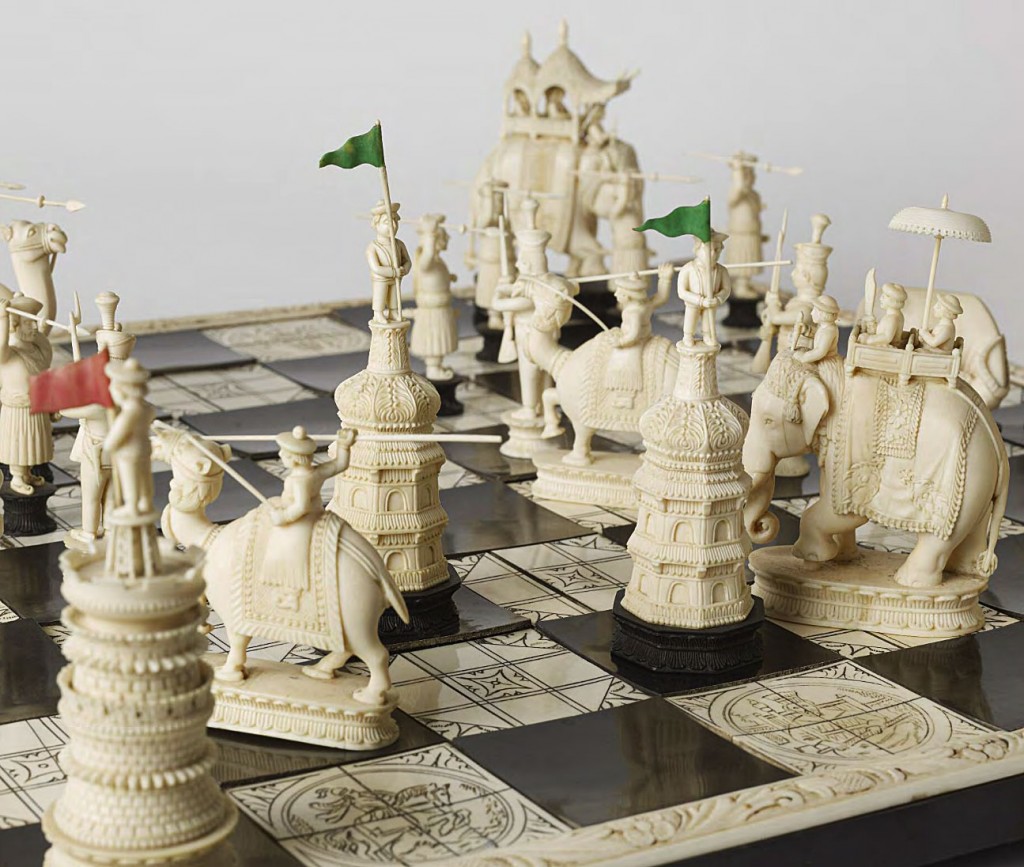
For more than a century, most games of chess have been played using a familiar set of abstracted black-and-white pieces, with minimal variation in size and detail. Known as the Staunton pattern, the design was named after Howard Staunton, a British player famous during the mid-19th century when the style was first created by Nathaniel Cooke. But the Staunton pattern’s prevalence today in “The Queen’s Gambit” era belies the variety of the game’s physical incarnations throughout history—in the past, chess was never quite so black and white.
“The most elaborate sets were like small sculptures.”
The game’s historical diversity begins with its pieces: Kings, queens, bishops, knights, and rooks have been sculpted from precious metals, ivory, gemstones, porcelain, and even matchsticks. Chess sets have featured underwater creatures, literary characters, fantastic monsters, and real-world armies. Throughout the game’s existence, which stretches back a millennium and a half, craftsmanship has often been as important as playability, such that many sets were made to be purely ornamental, rather than for actual use.
“Chess is a game of conflict, so the two opposing sides are often represented as one country against another country or religion against religion,” says Jon Crumiller, a lifelong competitive chess player turned collector. “But there are also sets with people against animals, good versus evil, or various mythological characters against other mythologies. They can be anything.”

Top: An elaborate East India Company set made from ivory around 1830. Above: A red-and-white Staunton pattern made by Jaques of London in the late 19th century. All photographs by Kevin Dutton. Published by FUEL in association with World Chess by Agon Ltd.
Crumiller started seeking out historic chess sets around 2002 after he stumbled onto an antique Staunton set on eBay. Starting with this set made by Jaques—a company Crumiller refers to as the Rolls Royce of chess, which also happened to be the first to produce the Staunton design—Crumiller has since accumulated around 650 sets. Several of Crumiller’s sets are included in the new book Masterworks: Rare and Beautiful Chess Sets of the World, whose informative text he helped write. The book features exquisitely crafted games originating in a wide variety of countries, cultures, and eras.
Checkered boards date at least to the ancient Egyptians, but the closest predecessor to chess was a game known as chaturanga developed in 6th-century India. “It was a four-person game for the most part,” Crumiller says, “with each person’s army coming from one of the four sides, and some of the pieces moving similarly to chess.
“The game progressed and evolved into shatranj, a board game in Persia,” he continues. “There are Arabic manuscripts from approximately 900 A.D. into the Middle Ages with wonderful chess problems, and by chess, I mean the chess of that age. The most brilliant chess problem I’ve ever seen is by as-Suli, which is pre-1000 A.D.”

A green-and-white Muslim chess set from South Asia with ivory pieces and a lacquered-wood board, circa 1700.
As the game moved across the globe, different patterns and rules became popular in different regions. “The Chinese version of chess is called xiangqi and there is sittuyin in Burma,” Crumiller says. “In Thailand and in Cambodia, there’s makruk. You can use those sets to play a game of chess, but those games are played with different rules.”
While some of these varieties included detailed figural chess pieces, so-called “Muslim sets” relied on more abstracted, geometric pieces whose size and shape indicate their roles. Crumiller explains that despite the name, scholars have found evidence that the style predates the existence of Islam in Persia. Regardless, the religion and popular game became linked, and chess often spread to new areas hand-in-hand with Islam.
In Persia, a piece known as the king’s advisor or “vizier” was also incorporated, which would later morph into the more powerful queen. “In 1283 there was a book published in Spain by Alfonso El Sabio, or Alfonso the Wise, called The Book of Games,” Crumiller explains. “The book still used the old chess rules, where bishops can only move every other square along the diagonal, or two squares, period. The queens were the weakest pieces—they had to stay near the king and could only move one square at a time.”

Featuring pieces made from crystal and smoky topaz with silver and gilt details, this early 16th-century set is remarkably similar to one owned by King Louis XVI of France.
“At the end of the 15th century, the rules changed dramatically. That’s when the queen became ‘La Rabiosa,’ or the Mad Queen, and the rules for bishops changed, too. At that point, it became more recognizable as our modern game, and several books were published that included both the old rules and the new rules, so clearly it was in a transition state.”
In her 2004 book, Birth of the Chess Queen, historian Marilyn Yalom links the shift in the queen’s status to the rise of charismatic female leaders throughout Europe, including Queen Isabella of Castile, Spain; Matilda of Tuscany, Italy; and Catherine the Great of Russia. In her book, Yalom points out that even as the powerful female character changed the rules of chess, the game’s increasingly fast-paced, combative quality meant fewer women were actually playing, as it was deemed unsuitable for the feminine temperament.
One of the female-centric figural sets featured in Masterworks is an 18th-century amber game possibly owned by none other than Catherine the Great. The pattern features a portrait of Catherine herself as one of the queens partnered with a king modeled on her lover, Prince Grigory Potempkin. The couple is facing off against an army helmed by her disloyal son, Prince Paul I, and his wife.

This chess set, featuring busts of Catherine the Great and her political counterparts, was carved from the amber mined in Kaliningrad, Prussia, circa late 18th century. (Click to enlarge)
Though this set was designed for actual play, Crumiller says that most figural sets—where pieces resembled specific, recognizable characters—were strictly ornamental. “They’re easy to identify because they’re so intricate and fragile,” Crumiller says. “There were also figural sets made for play, like Lieutenant-Colonel James Tod’s set, which was made for him as a gift in Rajasthan. You can clearly see it’s a playing set because all the pieces fit easily on the board’s spaces and are clearly visible behind one another so you can play a game with them.”
In the early 19th century, Tod was an officer in the East India Company, a British-run colonial enterprise reaping the benefits of India’s natural resources and low-paid labor force for manufacturing exportable products, especially made for markets in the U.K. and Australia. Highly detailed chess sets were a popular item for the British elite. “The most elaborate sets were like small sculptures used for display in a sitting room belonging to someone like a British general who oversaw the East India Company’s export market,” Crumiller explains. “In the sets with juggernauts or horse-drawn chariots instead of bishops, each of those pieces took up nearly half the length of a chessboard, so you could not play with those.
“The craftsmanship was just amazing,” he continues, “but it was very close to slave labor because the British had these goods made by indigenous craftsmen and then shipped back to Britain to make a profit. The East India Company’s sets were informally called ‘John Company sets,’ but there were other types of sets for export as well. These were often from ivory-producing places in India like Vizagapatam, Berhampore, and Rajasthan. You can tell where a set was produced by its style. Other areas used different raw materials, like jade, and some places had expertise in certain artistic techniques, like lacquer.” Even rarer than these export sets are those made for Indian royal families, which were typically unique, one-off creations.
Meanwhile, Western Europe was making its own popular designs. “By the mid-19th century, France, England, and Germany were all big chess centers with clubs, but each used different styles of chess sets,” Crumiller says. “For example, in France, they had the Directoire style and the Régence style, named after the famous Café de la Régence.”

Theses late 19th-century ivory pieces were modeled on characters of a well-known fable, “Reynard the Fox.”
In the 1830s, British player Howard Staunton rose in prominence, eventually playing two matches against Pierre Saint-Amant of France, who was considered the strongest player in the world. “In the second match,” Crumiller says, “he beat Saint-Amant and thus took on the mantle of the best player in the world. Staunton launched his chess column in the “Illustrated London News” during the 1840s and quickly became the leading authority on chess. In March of 1849, one of the publishers of the “Illustrated London News,” Nathaniel Cooke, patented a new chess set design, which he named after Staunton.
“Staunton endorsed Cooke’s product and was happy to have his name attached,” Crumiller explains. “They had some sort of commercial agreement, and it’s considered to be one of the first celebrity sponsorships of a product. Every set that was sold came in a box that Staunton personally signed.”
As Crumiller notes, Cooke’s design had several advantages over the various games being used at the time. “The pieces aren’t hidden behind other pieces; their weight and balance is good so the pieces don’t fall over easily; and they don’t take up too much room or too little room. It’s really beautifully designed,” he says.
But the Staunton pattern also helped solve the issue of competition between players from different regions of the chess-playing world, establishing a more universal form of the game. “A really good analogy is languages,” Crumiller says. “Someone who’s bilingual and speaks fluently in two languages doesn’t have any problem at all switching, right? The same is true with chess-set patterns.”

This paper-and-cardboard interpretation of the Staunton pattern was made during the Siege of Leningrad, a 900-day military blockade during World War II. (Click to enlarge)
The Staunton pattern grew in popularity over the next 50 years, and its fate was finally sealed when the World Chess Federation, known as FIDE (a French acronym for Fédération Internationale des Échecs), adopted the Staunton set as its tournament standard in the 1920s. To this day, it’s the only type of chess set you can use at an official FIDE tournament.
Since the pattern’s takeover, the Staunton set has been reworked by designers seeking to update it with a more modern sensibility, like Josef Hartwig’s early 1920s Bauhaus pattern or Cy Endfield’s portable design made for the World Chess Championship in 1972. Still other variations have arisen out of practical considerations, like the chess set designed by Soviet engineer Mikhail I. Klevtsov in 1970 for use in zero gravity aboard the Soyuz 9 mission in space, during which two cosmonauts spent 17 days and 16 hours in orbit around the earth. Still, although it seems like the Staunton pattern is ubiquitous today, Crumiller points out that there’s a newer version that might soon replace it as the most widespread form of chess—the digital game.
(For more incredible chess designs, check out Jon Crumiller’s World Chess column, “The Chess Collector” as well as the full collection in “Masterworks: Rare and Beautiful Chess Sets of the World.” All photographs by Kevin Dutton. Published by FUEL in association with World Chess by Agon Ltd. If you buy something through a link in this article, Collectors Weekly may get a share of the sale. Learn more.)

























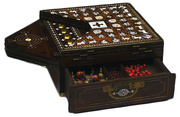
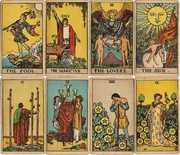 Tarot Mythology: The Surprising Origins of the World's Most Misunderstood Cards
Tarot Mythology: The Surprising Origins of the World's Most Misunderstood Cards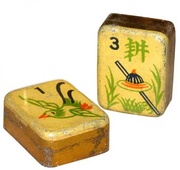
 At Home with the Maharajas
At Home with the Maharajas Tarot Mythology: The Surprising Origins of the World's Most Misunderstood Cards
Tarot Mythology: The Surprising Origins of the World's Most Misunderstood Cards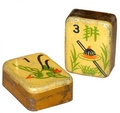 Antique Mahjong Sets: An Antidote to Our Antisocial Internet Society
Antique Mahjong Sets: An Antidote to Our Antisocial Internet Society Chess SetsFew board games can claim the same breadth of history as chess, which span…
Chess SetsFew board games can claim the same breadth of history as chess, which span… Mari Tepper: Laying it on the Line
Mari Tepper: Laying it on the Line Nice Ice: Valerie Hammond on the Genteel Charm of Vintage Canadian Costume Jewelry
Nice Ice: Valerie Hammond on the Genteel Charm of Vintage Canadian Costume Jewelry How Jim Heimann Got Crazy for California Architecture
How Jim Heimann Got Crazy for California Architecture Modernist Man: Jock Peters May Be the Most Influential Architect You've Never Heard Of
Modernist Man: Jock Peters May Be the Most Influential Architect You've Never Heard Of Meet Cute: Were Kokeshi Dolls the Models for Hello Kitty, Pokemon, and Be@rbrick?
Meet Cute: Were Kokeshi Dolls the Models for Hello Kitty, Pokemon, and Be@rbrick? When the King of Comedy Posters Set His Surreal Sights on the World of Rock 'n' Roll
When the King of Comedy Posters Set His Surreal Sights on the World of Rock 'n' Roll How One Artist Makes New Art From Old Coloring Books and Found Photos
How One Artist Makes New Art From Old Coloring Books and Found Photos Say Cheese! How Bad Photography Has Changed Our Definition of Good Pictures
Say Cheese! How Bad Photography Has Changed Our Definition of Good Pictures Middle Earthenware: One Family's Quest to Reclaim Its Place in British Pottery History
Middle Earthenware: One Family's Quest to Reclaim Its Place in British Pottery History Fancy Fowl: How an Evil Sea Captain and a Beloved Queen Made the World Crave KFC
Fancy Fowl: How an Evil Sea Captain and a Beloved Queen Made the World Crave KFC
Boycott ivory. Save the elephants
I have a Meerschaum chess set I purchased in Eskişehir Turkey in the 1980s, very ornate. Is there much collector interest in these sets.
I have a meerschaum set I bought in Eskisehir, Turkey in the late 80s, is there much interest in these sets.
I am very interested in Meerschaum chess sets, but the selection/availability is quite poor. Is there a specific store used by you? Any ideas where to find them in Turkey? Thanks.
Who would I contact to about a Staunton chess set from 1856. We have all the “I”men with the stamped pieces,Jaques London, the “casket” box with red label, # 3613. 3 for the red label. 613th set. Also lite green the chess player text book by H.Staunton.